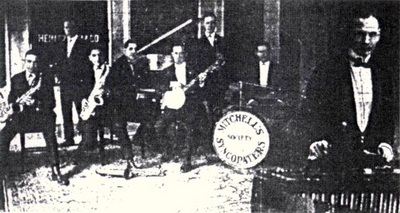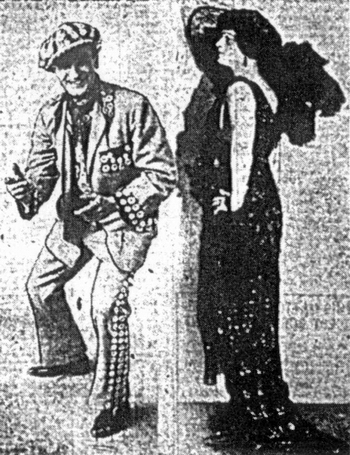|
Toronto Recording Artists On Radio
Part Two
by Arthur E. Zimmerman
The seventh concert included Gordon Mitchell’s Society Syncopaters, shown above, photographed at the
Heintzman & Co. store in Toronto. There were two saxophonists listed in the band, Oscar Burnside and Nat Cassells.

|
|
For years the Star had presented a weekly
series of free public concerts around
Toronto, the programs managed by The Star
critic and featuring the wealth of musical talent in
Toronto: music teachers, advanced students, church
soloists and instrumental ensembles. The venture
into radio was an exciting experimental leap for the
newspaper, to use the new and still imperfect
wireless telephone to transmit these Star
demonstration concerts to a wider public.
Delivering concerts broad-cast through the ether
was still a new, daring concept that was just
catching on in the United States, for this was just at
the beginning of the radio boom.
The 7th concert, April 20, 1922, was a variety
program combining classics, jazz and elocution.
Gordon Mitchell (of Detroit) and his Syncopators
contributed the jazz (Gordon Mitchell, piano;
Gordon Jones, violin; Harold Foss, sax; Oscar
Burnside, sax, Bud Brown, tenor banjo and Jack
Richardson, drums). On April 25, the 8th concert
featured Gordon Mitchell’s Society Syncopators,
the personnel altered to include Nat Cassells,
saxophone, and Gordon Newnham, xylophone.
Cassells also stepped up to the horn to play "When
the Buddha Smiles" with Gordon Jones, violin, and
Gordon Mitchell, piano. Cassells was a member of
the Romanelli Orchestra in 1922 and later joined
Captain Plunkett’s Overseas Orchestra
(see CAPS 001).
An Hawaiian trio, consisting of Paul T. Mulliette
and Tom and Sydney Pritchard, participated in the
9th concert, on April 28. Sydney Pritchard later
exchanged his ukelele for a banjo, playing and
recording with Fred Culley and His Royal York
Hotel Orchestra (CAPS 001). The same group, as
the Compass Guitar Trio, appeared on the 12th
concert, May 9.
Manny Roth, boy violinist, played on the 10th and
11th concerts, May 2 and 5, the latter broadcast
billed as "Boys’ Night on The Star Radio". A von
Kunits pupil, Manuel Roth was selected by Leopold
Stokowski for the Philadelphia Orchestra in 1924
and performed and recorded with them for over 45
years.
Bert Henderson and His Orchestra contributed
several dance numbers to the 12th concert on May
9 (Bert Henderson - piano; H.C. Bramhall
- sax; Leonard Robinson - violin; Charles Lownes -
trombone; Bud Brown - tenor banjo and John
Frizzell - traps. This John Frizzell may really be
Gene Fritzley, who played drums in concert #6 with
Frank Wightman’s Famous Orchestra). Broadus
Farmer, a Hambourg and Czaplinski pupil, played
as well and recordings of his artistry may be
preserved in the CBC Archives.
Chief Deskaheh of the Six Nations Reserve at Brantford in front
of the CITCo/Toronto Star microphone. The Star commented that
"It was the first time in history that the tongue of the original
Canadians had been broadcasted by radio".

|
|
The top billing of the 14th concert, May 17, was a
genuine war-whoop by Chief Deskaheh of the Six
Nations Reserve, Brantford, Ontario, followed by a
speech in Cayuga and then in English. Also on the
program were Leslie Allen, saxophone, playing
"Saxena" and "Everybody Calls Me Honey", and
Alfred Noakes, cornet, giving "Wild Rose Polka"
and "Smilin".
The mellow, yet penetrating notes skipped up
and down the scale and they skipped into the
horn and were forthwith lost to the ears of
those in the broadcasting room - but gained by
one hundred times as many ears in the
"big circle" outside. Mr. Allen’s piano
accompanist was Earle Estelle, who followed
unerringly the saxophone’s wandering trail.
After Chief Deskaheh had stated the claims of his
people, Leslie Allen’s "Radio Seven", probably a
single-purpose pick-up band, took over and was
the spice of the musical program. These seven
young players, Will Evans, drums,
Alfred Noakes, cornet, Earle
Estelle, piano, Jack Kean, violin,
Fred Boddington, saxophone,
Leslie Allen, saxophone and E.
Robson, banjo, played "Venetian
Love Boat", with piano solo
"Kitten on the Keys"- in their
own arrangement - in very lively
fashion. "Ohio Shore" was more
dreamy. It glided like the river.
Miss Vera McLean returned for the
Empire Day program, #15 on May 23,
to sing "Break O’Day" and "Annie
Laurie", and Leslie Allen came back,
this time playing in Jack Kean’s
Orchestra (Jack Kean, violin; Earle
Estelle, piano; Leslie Allen and Fred
Boddington, saxophones; Ernest
Robson, banjo and Will Evans, drums).
They wailed through "Stealing", "She
Loves Me, She Loves Me Not", "Dear
Love, My Love" and "Deep in Your
Eyes". Joseph Quintile, first harp
teacher at the Toronto
Conservatory of Music, contributed three numbers.
It wasn’t until the 19th and last concert
in the 9AH/CKCE series for The Star,
on June 14, that another recording
artist appeared. Ben Hokea brought his
Hawaiian Novelty Orchestra to the
CITCo studio (Ben Hokea, steel guitar; Mrs.
Hokea, piano; Percy Barber, saxophone; Travor
Jones, violin; John D. Kakalia, Spanish guitar and
Lorne Hanlon, banjo).
Hokea’s Hawaiian Novelty Orchestra
started with a soothing South Seas
medley, "One, Two, Three, Four",
concluding in a burst of rhythmic jazz.
...... This orchestra is indeed a novelty
one. The instrumental selections were
interspersed with vocal choruses and chants,
which added to the effectiveness of the
numbers ...... two selections,
"Aloha-oe", "Swing Me in the
Moonlight" and a medley concluding
with "The Beach at Waikiki", and they
certainly gave a delightful presentation
of the Waikiki beach with the swaying
Hawaiian melodies.
The rest of the program was provided by Salvation
Army musicians.
In addition to the twice-weekly 8:30 pm radio
demonstration concerts, The Star began a daily
series of 30-minute programs at 7 pm on April 10.
The format soon crystallized, beginning with The
Star’s late financial bulletin, followed by news of
sport, a guest artist or speaker, a children’s bedtime
story told by Miss Ruth Strong of the Toronto
Public Library, a political bulletin telegraphed from
The Star’s parliamentary correspondent in Ottawa,
and concluding with a second musical number.
Two of the famous Dumbells, from the Dumbells Revue of 1922:
"Red" Newman (1887-1952) in a Pearly Kings costume and female impersonator Ross Hamilton
(1889-1965) as "Marjorie".

|
|
Most of the guest artists who broadcast in this 7 pm
series are now forgotten, but on May 20 the young
violin pupil of Ferdinand Fillion and von Kunits,
Geoffrey Waddington, appeared to play two
classical pieces. Waddington conducted
CKNC’s Canadian Eveready Concert
Orchestra for Victor Records in1928, was
later music director for the Canadian Radio
Broadcasting Commission and the CBC,
and recorded conducting various CBC
orchestras. Sports editor William A. Hewitt
was also scheduled that night, talking about
the results of the King’s Plate, run at
Woodbine earlier in the day.
The Dumbells, the Canadian Third Division
Concert Party, who were currently at
Ambrose Small’s Grand Opera House in
their "Dumbell Review of 1922", showed
up twice on the 7 pm Daily Program. On
May 22, Al Plunkett ("K-K-Kiss Me
Again"), "Red" Newman ("I’m a Daddy")
and Ross Hamilton ("Say You Will Not
Forget") performed in front of the horn and,
on May 29, Jimmie Goode ("I Makes Mine
Myself"), Freddie Fenwick ("Joshua) and
Arthur "Jock" Holland ("Something Doing
Across the Way") dropped in. The
Dumbells and Captain Plunkett’s Overseas
Orchestra were Berliner HMV recording
artists.
Frank Oldfield, popular Canadian baritone
and a Berliner HMV and Pathe recording
artist, sang solos and duets on the June 26th
edition of the 7pm Daily Program.
Dr. Herbert Austin Fricker, director of the Toronto
Mendelssohn Choir, addressed the little fibre horn
on April 29 on "Toronto as a Musical Centre". Dr.
Fricker conducted the Toronto Mendelssohn Choir
for Brunswick and the C.N.E. Chorus for Canadian
HMV.
June 22, 1922, was the Grand Opening of CFCA,
The Toronto Star broadcasting station, located in
The Star Building, 18-20 King Street West. CFCA
would hereafter take the place of CKCE as the
source of The Star programs. The new station had
been designed and built by Dr. Charles A. Culver
and hisstaff from CITCo. CITCo also rigged up
the famous little white Star truck, with "Radio
Station No.1" painted on the side, that Foster
Hewitt and "Ted" Rogers used to take out to parks
and fairs to show off CFCA to the public. A few
days later, on June 26, Dr. Culver produced and
directed for Filmcraft Industries, Toronto, a feature
silent movie on the new station. The picture was
shot in the CFCA studios during a broadcast and
was shown at the end of August at the Allen
Theatres in Toronto, Ottawa, Windsor, Kingston,
London, Stratford and Montreal, as well as at the
CNE. There had to be multiple prints, so where is
that film now?
The Toronto Star radio concerts continued on
CFCA with live musicians and an impressive
innovation, The Star Orchestra directed by
Reginald Stewart. But that is a subject for future
research.
Bibliography and credits
- J.E. Atkinson ofthe Star - Ross Harkness,
U of T Press, 1963
- Toronto Daily Star, 1920-1922
- Roll Back the Years - Edward Moogk,
Ottawa, 1975
- Dance Bands from Canada, 1922-1930
(CAPS 001), notes by Colin J. Bray, 2000
- Encyclopedia of Music in Canada (eds.
Kallmann, Potvin & Winters, U of T Press,
1981)
Thanks to Bill Pratt and David Lennick
Arthur E. Zimmerman is author of "In the Shadow
of the Shield" (657 pp), a fully documented oral
history of wireless and radio broadcasting at
Queen’s University and in Kingston, Ontario,
1902-1957. He is currently researching the earliest
years of the Montreal and Toronto Marconi radio
stations, XWA/CFCF and CHCB, respectively, and
is looking for biographical information on the
Canadian singers Gus Hill, and Dorothy Lutton, as
well as for copies of the magazine Canadian
Wireless (June 1921-July 1922). He can be
reached by telephone at (416) 923-2001 or by
e-mail at arthurz@look.ca
|